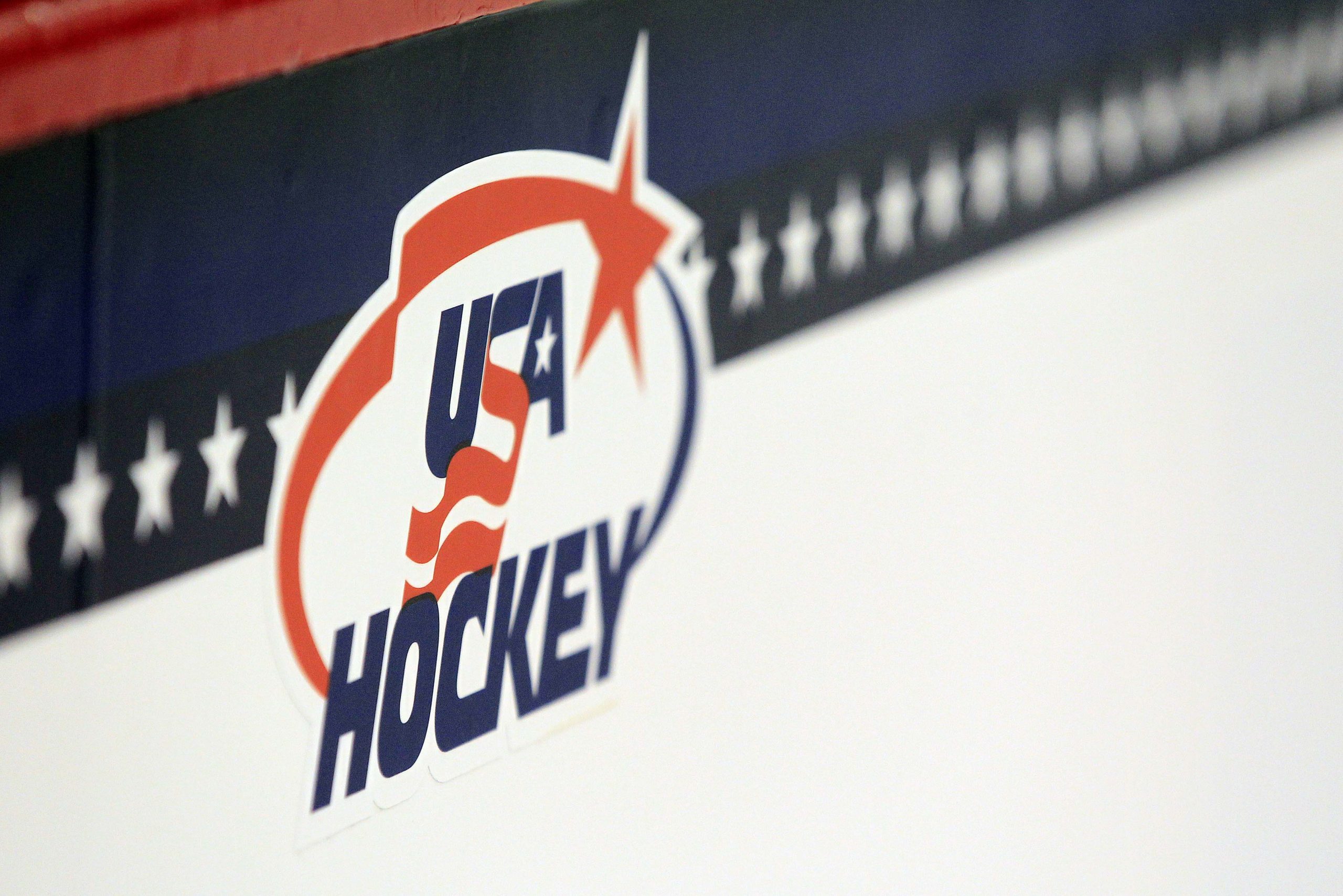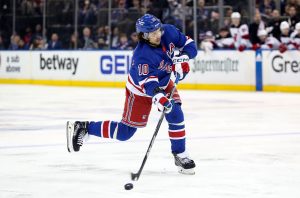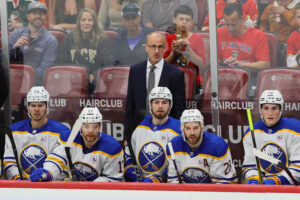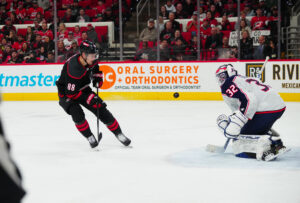The 2023 NHL draft class is a loaded one. From the top with Connor Bedard and Adam Fantilli, it is arguably one of the best classes in recent memory. Add to the fact that there are some intriguing names throughout the projected first-round, and it’s clear this draft is also deep. The USNTDP also holds several high-end players. One of those players is Will Smith.
Will Smith Scouting Report
Will Smith, born March 17th, 2005, in Lexington, Massachusetts, is a center playing for the USNTDP squad. He stands 6’0” and 172 pounds, which is decent size for a 17-year-old. He is currently committed to Boston College, per elite prospects, for the 2023-24 season. Smith first landed on the NHL world’s map last season, when he scored 14 goals and 13 assists for 27 points with the NTDP’s U18 squad in 28 games, at 16-years-old. He added 17 goals and 20 assists for 37 points with the U17 squad that year as well.
So far this season, Smith has recorded 36 goals and 53 assists for 89 points in 45 games, a ridiculous statline. That includes nine goals and 17 assists for 26 points in 13 games against USHL competition. That insane statline has led him to be a near-consensus top-10 pick. Notable sites and experts have him ranked accordingly: ranked fifth by Draft Prospects Hockey, Recruit Scouting, SportsNet, McKeen’s Hockey, and The Hockey News; ranked sixth by FCHockey, Bob McKenzie, and Craig Button; ranked seventh by Daily Faceoff; ranked eighth by EliteProspects and DobberProspects; and finally, ranked 17th by Smaht Scouting. This writer skews more towards where Smaht Scouting has Smith ranked, placing him 17th as well on his unreleased list.
Will Smith Deep Dive
For the most part, everyone seems to be in agreement with where Smith should land. Just outside the top-five, due to how insane the top-five is shaping up to be, but inside the top-10. But then there’s the small contingent of scouts who have him ranked outside the top-10, or even the top-15. Why are most people high? Should there be some longer pauses when looking into taking him top-ten?
Smith’s Skating
Will Smith is a very good skater. He isn’t great, he doesn’t burn defenders consistently, but he has the makings of a player who could someday be considered elite in this department. Perhaps his best asset in his skating is his edgework. His transition from forwards to backwards skating is near-flawless. When he flips his hips to change direction, there isn’t even a split second where he loses speed. That ability to change direction and pivot almost perfectly will be a massive asset at any level of hockey.
Add to his edgework his solid top-end speed, and you have a player who does not need to have elite speed to be a dangerous skater. His acceleration and first few strides are good, and with added muscle mass over the next few years with his college or pro coaches, can be improved. Smith could easily become an elite level skater at some point down the line.
Offensive Abilities
When it comes to Will Smith’s game, this is the most attractive to scouts. His offensive game is something to admire sometimes. His hands are phenomenal, and paired with his skating, is dangerous. He possesses a fantastic vision and can target teammates in high-danger areas consistently. When it comes to scoring, he can stick handle through everyone and get to dangerous areas himself to generate scoring chances. He’s got a pretty complete offensive skill set. But, this is also where concerns may arise.
Shooting Ability
Across three tracked games, Smith fired the puck 12 times, with 10 hitting the net in even-strength scenarios. Of those shot attempts, he fired eight from high-danger, which included seven on net, and one being a goal. His high-end ability to get pucks to high-danger consistently is impressive. Perhaps what aids him best is his ability to find soft spots in coverage without the puck and opening himself up for a teammate. But, as mentioned earlier, he has a penchant for working through defenders using his high-end creativity in order to get to those areas too.
On the man-advantage, however, he fired seven shots, with only one hitting the net. Only two shots came from high-danger, and neither were on target. While he does play the half-wall and point area, a position that guys like Nikita Kucherov and Connor McDavid, it still is a bit concerning the lack of shots on target he generates. Because playing that role emphasizes passing more than shooting, generally, but Kucherov and McDavid both can make defenses pay if they’re given space to shoot.
Playmaking Ability
Meanwhile, as a playmaker more than a goal-scorer, Smith had his passing abilities on full display. In those same three games, Smith attempted 20 offensive zone passes and completed 10 of them, at even-strength. While that number certainly seems low, it’s more about the context of those passes. He isn’t merely a guy who looks to maintain possession with low-danger passes. Of the 20 attempts, 14 of them were aimed at high-danger. That’s 70% of his total passes being aimed at high-danger areas. However, there’s a caveat to that. He completed just five of those passes. That is a completion rate of just 35.7%.
Meanwhile, on the power play, he attempted 16 passes and completed 13 of them. Of those 16 passes, only four were aimed at high-danger. Of those four, two were completed, giving him a 50% completion rate. Again, it’s fantastic that he’s confident and willing to challenge the high-danger areas with the puck, but the efficiency wasn’t always there.
What The Numbers Tell Us
Looking at just the numbers, one would think Will Smith likes to shoot the puck more than pass it. When he passes the puck, he looks towards only setting up scoring chances rather than the bigger picture. Sam McGilligan, during the 2021 NHL draft, talked about “micro versus macro” abilities that players had in his “Best Of” series for McKeen’s hockey. Micro players are players who are faced with a dilemma and problem-solving that situation. Macro players are guys who can paint the whole picture by making the right solutions to get closer to the goal at hand – scoring.
Similar to how McGilligan explained Kent Johnson, Smith is a talented micro-player, who can stickhandle in a phone booth and make players look silly at times. However, the macro aspect of his game is lacking, as he doesn’t always make the right decisions. That’s evidenced with his 11 offensive zone turnovers, including two interceptions and nine giveaways. Smith focuses so much on trying to generate space with highlight reel-level skill moves, but loses sight of the bigger picture by putting himself in tighter spots than necessary and forcing passes to teammates consistently when the lanes aren’t necessarily there.
Will Smith’s Transitional Abilities
Smith’s transitional game is an interesting one. When it comes to entering the offensive zone, he can be really solid. In those same aforementioned games tracked, Smith was directly involved in 18 entry attempts at even-strength. He gained the zone, with possession, on 12 of them (66.67% success rate). He failed on four of them, compared to just two dump-ins. That, again, reflects the aforementioned micro versus macro issue, as he tends to try too much on his own rather than making the smarter play. But, overall, it does not negatively impact his game in this department too much.
As for exiting the defensive zone, however, flaws arise. He was involved in just 10 zone exits at even-strength. Smith exited the zone just four times with control, and of those four, just one was him carrying the puck out himself. Again, he failed four times to exit the zone entirely, versus just two uncontrolled clears. Once again, the micro versus macro argument reared its head. But perhaps what is more concerning is, generally, Smith took a back seat to his linemates more often than not transitionally, and more specifically, exiting the defensive zone. That’s reflected in Mitch Brown’s player card for Smith.
*Insert Player Card*
Diving Deeper Into The Transitional Numbers
Essentially, Smith is usually a plus transitional player, but overall lacks involvement at times. When he has the puck in the neutral zone, you can count on him to gain the offensive zone. In fact, he has a higher rate of success than notable prospects Zach Benson, Brayden Yager, and Fantilli. But, Smith averages six entry attempts per game in what was tracked, while Benson (16 per game) and Fantilli (11) both averaged a good chunk more. Not to mention controlled entries per game, where Smith averages four per game and Benson (10.33) and Fantilli (6.33) again average a good amount more. When it comes to fail rates, Smith is up at 22.22%, while Benson is at 16.67% and Fantilli is down at 9.09%.
It’s even worse when you look at his exits. He has a success rate of just 40%. That’s better than only Eduard Sale, who plays against men and has only one game tracked (20%). That’s compared to nine other forwards tracked, who are all considered first rounders. His fail rate is up at 40% as well, which is worse than Sale’s mark of 20% in his small sample. Suffice to say, he struggled in the sample that was taken. However, it’s still reflected in Mitch Brown’s above player card, where it shows “transition success %.”
Smith’s Defensive Zone Play
This area is another weakness in Smith’s game. Smith looks almost uninterested more often than not in his own end. He can be caught floating around at times, not really engaging on the back check or in board battles in his own end. That is reflected with him having just nine defensive zone touches (in two games, as they were not yet being tracked when the first game was watched). For perspective, outside of Leo Carlsson who plays against men, Gavin Brindley had the lowest with eight… in one game. Meanwhile, the next lowest is Bedard with 19 touches in two games, or an average of 9.5 touches per game.
Not to mention, Smith had two turnovers, or a 22.2% turnover rate, in his own end. The next highest turnover rate is Nate Danielson, at 17.86% in three games, and he had 28 total touches (9.33 per game). However, Smith has a tendency to read plays very well, showing high end anticipation. He has a knack for intercepting passes. But overall, the lack of effort and interest in the defensive zone trumps the positives he displays at this time.
Will Smith’s Potential
Smith’s potential is sky-high. Genuinely. Yes, there are some major concerns, specifically regarding the micro and macro aspects that were looked into. But with that high ceiling, you get a low floor, generally speaking. Smith doesn’t have the defensive abilities, motor, or physicality to play in a team’s bottom six, and the translatability of his game is tough to gauge. But if he hits and rounds out his game, he could be a dominant NHL player.
As for NHL comparables, from a playstyle standpoint, it becomes foggy. Smith is very similar to Kent Johnson at Michigan, though not as consistently flashy with the way he plays. There have also been some claims that he is similar to Tage Thompson, but smaller. Trevor Zegras is another player who comes to mind with flashy offensive play, lack of physicality, and not-so-great defensive involvement.
However, this writer believes Will Smith is similar to William Nylander stylistically. Or, at least, what Leafs fans believe Nylander is. Smith isn’t necessarily “soft” but he doesn’t get involved in board battles much anywhere on the ice. But, he possesses strong hands, excellent vision, and can score some goals. That’s roughly the style Smith plays, though he has some time to go before he reaches the level Nylander has in Toronto.
Visual from Mitch Brown
Tracked Stats from Kyle Pereira
Raw stats via Elite Prospects
Main photo by: Geoff Burke-USA TODAY






